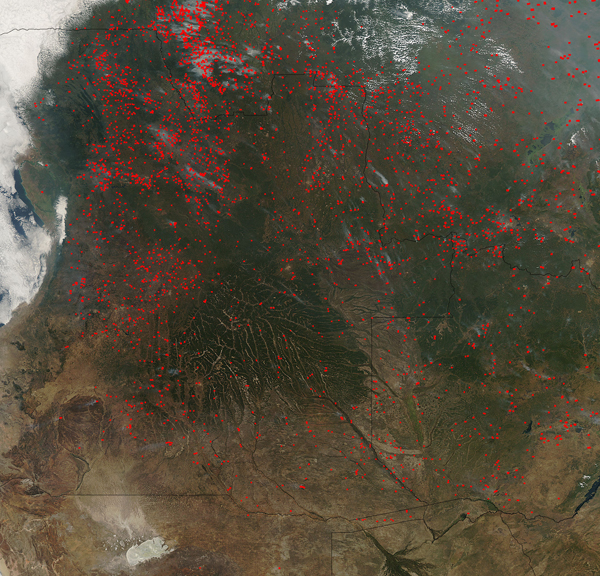Images
June 26, 2015 - Fires in southwestern Africa
Tweet
Small farmers in southwestern Africa have lit their fields on fire to get rid of extraneous plant materials and return the nutrients to the soil. The fires are outlined in red and accompanied by gray smoke. The heaviest clusters of red hotspots are in Angola, while both the Democratic Republic of Congo (northeast) and Zambia also have fires burning.
Most of the fires burn in grass or cropland. This type of field clearing is commonly used by small farmers, as it is the easiest and most cost effective and does not require an investment in expensive agricultural equipment. While fire helps enhance crops and grasses for pasture, the fires also produce smoke that degrades air quality. A small fire can also slip out of control, causing a destructive wildfire.
About 90 percent of farmers throughout Angola are smallholders. They cultivate very small plots of land, with very low productivity since the civil war which ravaged the nation. This is most likely the reason that this type of field clearing is used so extensively. Large farmlands are no longer feasible since much of the fertile land was destroyed, leaving it littered with landmines and driving millions into the cities. Much of the food is now imported into the country.
The Moderate Resolution Imaging Spectroradiometer (MODIS) instrument on NASA’s Aqua satellite acquired this true-color image on June 15, 2015.
Image Facts
Satellite:
Aqua
Date Acquired: 6/15/2015
Resolutions:
1km (1.2 MB), 500m (11.3 MB), 250m (9.4 MB)
Bands Used: 1,4,3
Image Credit:
Jeff Schmaltz, MODIS Land Rapid Response Team, NASA GSFC
Tweet
Small farmers in southwestern Africa have lit their fields on fire to get rid of extraneous plant materials and return the nutrients to the soil. The fires are outlined in red and accompanied by gray smoke. The heaviest clusters of red hotspots are in Angola, while both the Democratic Republic of Congo (northeast) and Zambia also have fires burning.
Most of the fires burn in grass or cropland. This type of field clearing is commonly used by small farmers, as it is the easiest and most cost effective and does not require an investment in expensive agricultural equipment. While fire helps enhance crops and grasses for pasture, the fires also produce smoke that degrades air quality. A small fire can also slip out of control, causing a destructive wildfire.
About 90 percent of farmers throughout Angola are smallholders. They cultivate very small plots of land, with very low productivity since the civil war which ravaged the nation. This is most likely the reason that this type of field clearing is used so extensively. Large farmlands are no longer feasible since much of the fertile land was destroyed, leaving it littered with landmines and driving millions into the cities. Much of the food is now imported into the country.
The Moderate Resolution Imaging Spectroradiometer (MODIS) instrument on NASA’s Aqua satellite acquired this true-color image on June 15, 2015.
Image Facts
Satellite:
Aqua
Date Acquired: 6/15/2015
Resolutions:
1km (1.2 MB), 500m (11.3 MB), 250m (9.4 MB)
Bands Used: 1,4,3
Image Credit:
Jeff Schmaltz, MODIS Land Rapid Response Team, NASA GSFC




